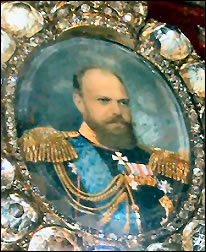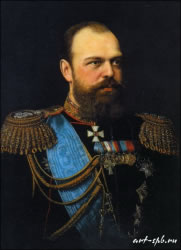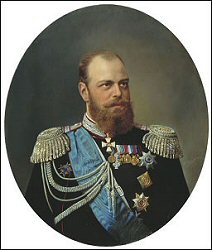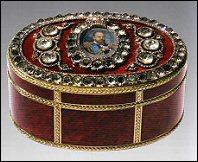

Bismarck Box
(Courtesy of the Hodges Family Collection)
An inscription, in this case added at a later time with an incorrect date, reads:
S.M.I. l’Empereur Alexandre III de Russie
á S.A.S. le Prince de Bismarck Chancelier de l’Empire Allemand
1884
(Presented by His Imperial Majesty the Emperor Alexander III of Russia, to His Serene Highness the Prince of Bismarck, Chancellor of the German Empire 1884)
Dr. Ulla Tillander-Godenhielm, authority on Russian Imperial awards, shared her insights on these unique reminders of historic significance. Official presentation gifts given by the Russian emperors were not engraved. This concerned both diplomatic gifts presented to foreign statesmen as well as official gifts to Russian subjects. Gifts of this type to Russians were not gifts in the traditional sense of the word, they were remuneration for service rendered to the Empire. A gift could be returned to the Cabinet of His Imperial Majesty for its value in money. The Cabinet would subsequently award the same object to another person. Gifts between members of the imperial family and gifts to bosom friends were, on the other hand, often engraved but these were personal gifts, not official gifts.
In advance of the October 1889 state visit to Berlin by Alexander III, the Cabinet of His Imperial Majesty commissioned a presentation gift for the German Chancellor Prince Otto von Bismarck from Fabergé, who had not earlier supplied objects of this kind to the Cabinet. The importance of the recipient required a very special and costly gift, and the price of the snuffbox by Fabergé amounted to a total of 12,215 rubles. A substantial part of the value consisted of the 77 brilliant-cut diamonds decorating the lid of the box, with a total value of 10,747.87½ rubles. The snuffbox was invoiced by Fabergé on September 20, 1889, and entered into the ledgers of the Cameral Department of the Cabinet of His Imperial Majesty the following day.
Additional facts gleaned from the Fabergé invoice found by Valentin Skurlov in the Russian Archives are:
- The price of the six large brilliants, each weighing approximately 3 carats, amounted in total to 3,780 rubles. They varied in quality as seen from their price per carat. The cost of the 642 small rose cut diamonds was billed at 312.81¼ rubles. The Perkhin workshop was paid 1004.31¼ rubles for the gold and workmanship (not specified separately) involved in making the box.
- An article in the New York Times (October 15, 1889) states two boxes were presented during the Berlin visit from October 11-13, 1889. The second box costing 8,313 rubles was presented to the State Secretary for Foreign Affairs of the German Imperial Court, a position held by Count Herbert von Bismarck, the eldest son of the Reichs-Chancellor. Dr. Tillander-Godenhielm discovered in her research that the snuffbox presented to the Count had been ‘recycled’ twice before and originally cost 3,988 rubles. The addition of expensive brilliant-cut diamonds made the box a worthy gift to this likewise important recipient.
- For the Reichs-Chancellor’s box made in the workshop of Mikhail Perkhin (1860-1903), the Fabergé firm would have been advised that the total cost of the gift should be in the region of 12,000 rubles. It was the most expensive box of the reign of Alexander III, followed by the one presented to Count Herbert von Bismarck. According to the accounts of the Cameral Department of the Cabinet of His Imperial Majesty, the presentation of the latter box took place after December 12, 1889. The value of the presentation boxes bestowed by Alexander III varied in general between 2000-4000 rubles.
- Diamonds from the Chancellor’s snuffbox were at a later stage replaced with paste stones, sized and cut to fit the original settings. The diamonds are now in a necklace still in the possession of a descendant of Prince Otto von Bismarck. (Keefe, 173)
The portrait miniature of Tsar Alexander III in the center of the Bismarck Box cost 150 rubles. Miniaturists generally based their work on original paintings of the tsars, so the miniature was more or less contemporary to the gift and the emperor was of the correct age. A search for a matching Alexander III portrait based on the traditional pattern has not yet yielded a positive match.
- A visual inspection of the Alexander III miniature by the owner of the box and the authors revealed it was painted by Alexander Matveevich Wegner (1826-1894), who was trained as a painter at the Imperial Academy of Arts in St. Petersburg and completed numerous miniatures of members of the Imperial family. (Biographical data in Sotheby’s London, Russian Art, November 2, 2009, Lot 129.) The re-dating of the Bismarck Box to 1889 eliminates Vasilii Zuiev, previously suggested as the miniature painter for this portrait. In 1889, Zuiev was 19 years old, a student at the Baron Stieglitz Central School of Applied Arts, and he did not begin working for the Office of His Imperial Majesty until 1904. (Biographical data in Sotheby’s London, Russian Art, November 29, 2010, lot 219.)
- The search for the original painting which served as Wegner’s model yielded some possibilities shown below. During the lifetime of the Tsar (1845-1894) photography using the dry gel on paper process became a popular hobby. Alexander III was the first Russian Emperor for whom black and white photographs exist. It is thus possible the Bismarck miniature was based on a photograph and painting combination.
The 5th Anniversary of publishing the Fabergé Research Newsletter is a time to reflect on the past. The adventure began with a one-page announcement of Fabergé events. Thanks to the contributions of Fabergé enthusiasts and scholars alike, it has grown to feature in-depth studies on specialized topics, spirited discussions, and the sharing of new discoveries. The announcements to keep you informed about happenings in the Fabergé world continue to come from readers worldwide. We are looking forward to more exciting contributions from our readers, and to meeting you during the opening events in Richmond, Virginia. Christel and Annemiek
Russian Art
Includes a Fabergé tankard, a silver dinner and dessert service, an étui in the racing colors of Leopold de Rothschild, a study of cornflower and oats in a rock crystal vase, and a French edition of the Fersman Portfolio, Les Joyaux du Trésor de Russie (1925), with text and illustrations of the Russian crown jewels for sale by the Bolsheviks.
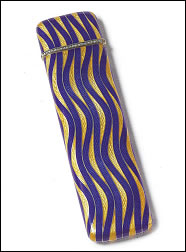
Rothschild Étui
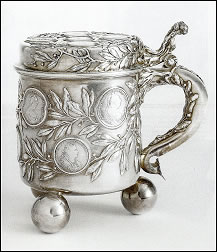
Tankard
June 6, 2011 Christie’s London
Russian Art
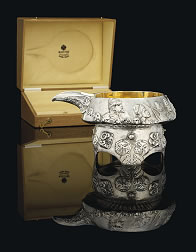
Coupe à Bec
Gift from Emanuel Nobel
(1859-1932)
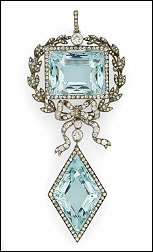
Aquamarine and Diamond
Pendant Brooch
(Both Photographs: Courtesy Christie’s)
(Updates are posted in Exhibitions on the Fabergé Research Site)
March 17 – June 12, 2011 Liechtensteinisches Landesmuseum, Vaduz, Liechtenstein
Das Osterei – Liebespfand und Kunstobjekt
Special exhibition of Easter eggs from the Collection of Adulf Peter Goop to celebrate the 90th birthday of the collector. In June 2010, Goop donated to the Fürstentum Liechtenstein his wide-ranging art collection, including over 2,000 elaborately decorated Easter eggs. In March 2011, the Liechtenstein Postal system issued a stamp series dedicated to the decorative eggs collected by the Liechtenstein art connoisseur.
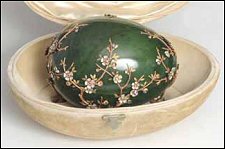
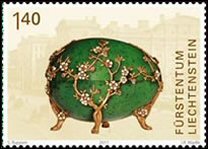
Kelch Apple Blossom Egg and Stamp
(Courtesy Liechtensteinisches Landesmuseum and Philatelie Liechtenstein)
Fabergé: Holy Images
Icons and Fabergé objects totaling 180 pieces from “The Link of Times” Collection, owned and repatriated to Russia by Viktor Vekselberg, will be shown. The Fabergé objets d’art were acquired in 2004 from The Forbes Magazine Collection, and are only shown from time to time.
June 30 – July 5, 2011 Former Chelsea Barracks, London
Masterpiece London 2011 A La Vieille Russie, New York, and Wartski, London, will be exhibiting.
- The House of Fabergé – Géza von Habsburg
- Behind the Scenes at Fabergé: The St. Petersburg Workshops – Ulla Tillander-Godenhielm
- Fabergé and His Russian Competitors – Géza von Habsburg
- Fabergé and His Foreign Competitors – Géza von Habsburg
- Mrs. Pratt’s Imperial Easter Eggs – Carol Aiken
- The Zarnitsa Sailor and His Place in History – Christel Ludewig McCanless
- Fabergé and Grand Duchess Maria Pavlovna – Alexander von Solodkoff
- Lillian Thomas Pratt and A La Vieille Russie: A Personal Relationship – Mark Schaffer
- Fauxbergé – Géza von Habsburg
- Illustrated Catalog of the Fabergé Collection, Other Makers, and Forgeries
Historical survey of Russian silver production from before 1700 to 1917, includes two chapters relating to Fabergé, The Russian Style to Fabergé and Fabergé to Modernism.
Tillander-Godenhielm, Ulla. Fabergén suomalaiset mestarit (Fabergé’s Finnish Workmasters), 2011. Revised edition with more in-depth research of a 2008 numbered edition with the title, Fabergé ja hänen suomalaiset mestarinsa (Fabergé and His Finnish Workmasters). In Finnish.
An expanded look into the lives and production of Fabergé’s foremost Finnish workmasters, beginning with Pöntinen (Pendin), Holmström, Väkevä, Mickelsson, and Kollin, who began their tenure under Gustav Fabergé. They were followed by Wigström, Pihl, Hollming, Nevalainen, Nykänen (whose name has been erroneously spelled Niukkanen for the past century), Aarne, and Armfelt. The author, a Finn herself and descendant of St. Petersburg jeweler Alexander Tillander, has interviewed many of the descendants of these Fabergé craftsmen. The book is filled with their reminiscences.

Deribasovskaya #31
(Skurlov in The Great Fabergé, 1990, 57)
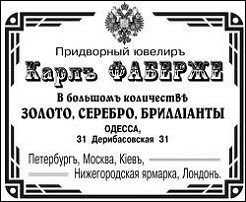
Online Advertisement

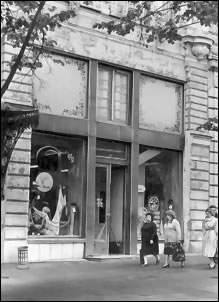
Deribasovskaya #31 Beginning of the 19th Century and in the 1990’s
(Our Thanks to Paul Kulikovsky and Valentin Skurlov)
Modern photographs compared to the ca. 1900 photograph confirm the shop location at Deribasovskaya #31.

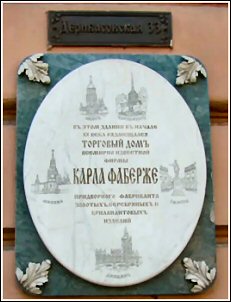
Panoramic View of Deribasovskaya Street 2010 with #31 (Arrow) and # 33 (Oval) Entrance to Passage with 2006 Plaque
(Courtesy of Ulla Tillander-Godenhielm and Paul Kulikovsky)
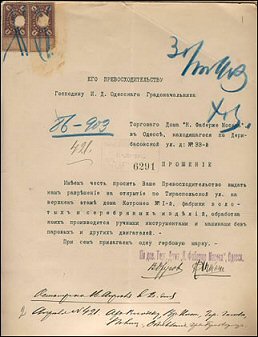
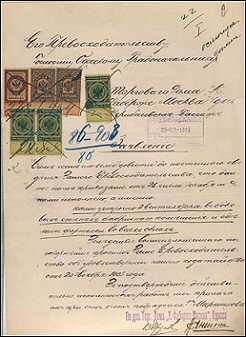
Documents for Odessa Atelier
(Courtesy of Paul Kulikovsky)

Christie’s Geneva, November 15-16, 1994, Lot 437, and Allan Bowe
(Courtesy Christie’s)
Four unique silk linings on extant presentation boxes displaying the stamped Fabergé business logo may help in dating Odessa pieces.

1900-1914

1900-1914

1915-1918

1900-1914
von Habsburg and
von Solodkoff, Fabergé:
Court Jeweller to the
Czars, 1979, 148
In her new book (cited above under Publications) Dr. Tillander-Godenhielm has solved the Gabriel Nykänen question. He spent his entire working career with the House of Fabergé in the St. Petersburg up to the revolution, and not in Odessa as sometimes suggested. His nephew Frans Botolf Nykänen (b. 1870) worked for Fabergé in Odessa. He moved with his wife and children to Odessa in 1903, but returned to Finland already in 1905. The father of Frans Botolf, Matts Nykänen (b. 1847) was also a goldsmith master in St. Petersburg. The research on the Nykänen family of goldsmiths is, however, still incomplete.
- Anna and Vincent Palmade spotted a Fabergé object owned by the Fine Arts Museums of San Francisco in archival photos. A pair of embracing amorini in the Louis XVI style was displayed in the 1902 von Dervis House exhibition (von Habsburg and Lopato, Fabergé Imperial Jeweller, 1993, 432-33, no. 363-365). Once owned by Alma de Bretteville Spreckels (1881-1968), a wealthy socialite and philanthropist who persuaded her first husband, sugar magnate Adolph B. Spreckels, to donate the California Palace of the Legion of Honor to the city of San Francisco. The Fabergé decorative object was donated by her daughter to the Palace collection in 1969. (von Habsburg, Fabergé in America, 1996, 6 and 55)

First Fabergé Exhibition, von Dervis Mansion, St. Petersburg, 1902
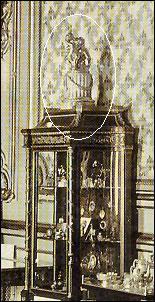
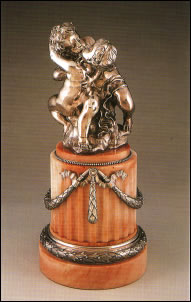
1902 Detail – Embracing Amorini
- Valentin Skurlov, Fabergé researcher in St. Petersburg, asked for a clarification on a general news item based on a Russian television story and reported in the Fabergé Research Newsletter, Winter 10-11. He wrote thanks to his research in the Russian Archives in 1989 he found a lead to the grave of Mikhail Perkhin at the Novodevichy Cemetery. In 2010, Alexander Gorynya and Skurlov (joint authors with Tatiana Fabergé of Fabergé and the St. Petersburg Jewelers, 1997) restored the tombstone.
- A reader found a photograph of Agathon Fabergé’s tombstone in the Smolenske Lutheran Cemetery in St. Petersburg. This Agathon (1862-1895) was the brother of Karl Farbergé, and the permanent designer for the House of Fabergé until his death.


